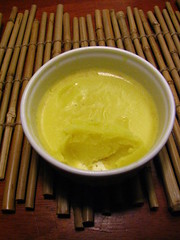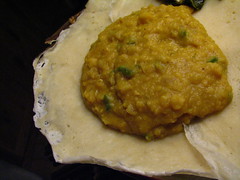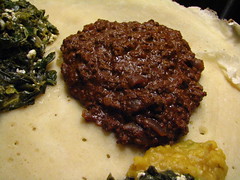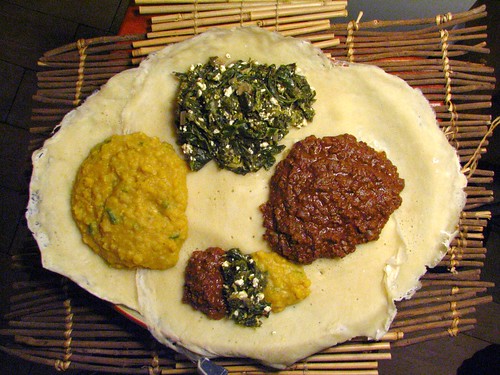Last week I had off from work for our “midwinter” break. It wasn’t a very relaxing week but cooking, for me, is very relaxing. Five hours of cooking can actually be quite relaxing as well. And that’s what happened when I decided to take on the challenge that Joan of Foodalogue put in front of her readers – create a dish from Ethiopia. I made six Ethiopian dishes and ingredients and, yes, it took me five hours to create all of it. But, in the end it was all worth it.
Ethiopian cuisine is one that I have only recently become acquainted with and when I first tasted it, I was hooked. While researching for this post I realized how little is out there on this fabulous cuisine. Anthonly Bourdain recently said that he believed Ethiopian food would be the next big trend in eating and I have to agree that it should be. It’s delicious, communal, flavorful, fun to eat and relatively healthy (except the ridiculously high amount of butter used in the dishes). We’ll see if his prediction is correct. I mean how can you go wrong when all you have to eat with is your hands and some deliciously sour, sponge and crepe-like bread called injera?
The two biggest staples of Ethiopian food are a spice mixture called berbere and a spiced clarified butter called niter kibbeh (see both recipe below). Many Ethiopian recipes utilize one or both of these ingredients. The other staple and accompaniment to Ethiopian food is injera bread which is traditionally made from a specific type of flour called teff and usually takes three days in order for it to ferment causing its sour taste. I didn’t have teff flour so I utilized Saveur magazine’s recipe which wasn’t as delicious as the authentic type but did the trick. Brushing lemon on the bread gave it a bit of the sour flavor I was craving. As mentioned earlier, injera bread is used as your plate, fork, knife and spoon when eating Ethiopian food. Your food will come in small piles scattered on a a big injera where you will tear off bits of the outside layer in order to get the food in your mouth. You continue until you eventually have to eat the layer that has sopped up all the flavors of each dish you chose. These are some of the best bits but you’ve got to get to the end of the meal to savor them.
Ethiopian food is like no other – it borrows ingredients from Portugal (chile peppers), the Orient (ginger) and India (spices) to create a taste that is very, well, Ethiopian and very different to anything you’ve ever eaten. Most of the recipes found below are based on things found in the cookbook Exotic Ethiopian Cooking and a blend of other website recipes I found. I recommend you all give Ethiopian a try, whether you have five hours to cook or have always been curious to try that Ethiopian restaurant down the street. Vegetarians and non-pork eaters will have a field day and even the pickiest of eaters will enjoy this fun and fabulous cuisine. So thank you, Joan, for pushing me to finally create Ethiopian food at home. Now that I’ve done it I’ll be doing it again. Now, I hope you will try your hand at it!
BERBERE (Ethiopian Spice Mix)
- 1/4 cup ground red pepper (about 8 Dried Chiles de Arbol, blitzed in a spice grinder)
- 1 teaspoon ground ginger
- 1 teaspoon garlic powder
- 1 teaspoon ground fenugreek
- 1 teaspoon ground cardamom (about 6-8 cardamom pods, blitzed in a spice grinder)
- 1/2 teaspoon ground nutmeg
- 1/2 teaspoon cloves (about 4-6 cloves blitzed in spice grinder)
- 1/2 teaspoon cinnamon
- 1/2 teaspoon ground allspice
- 3 tablespoons paprika
- 2 teaspoons dried onions, blitzed in grinder, or 2 tsp. onion powder
- 1 tablespoon salt and 1/2 tablespoon freshly ground black pepper
**Grind chiles in a spice grinder. Toast all seeds for about 3 minutes, allow to cool and add everything to spice grinder and blitz.Â
NITER KIBBEH (Ethiopian Spiced Butter) – Makes about 1/3 cup – for the effort you may want to double or triple this recipe

Â
- 1 stick + 1 tablepoon unsalted butter
- 1 inch piece of ginger, peeled and then grated on a microplane or grater
- 1 clove garlic, minced
- 1/4 red onion, finely chopped
- 1/4 teaspoon ground fenugreek
- 1/4 teaspoon ground cardamom
- 1/2 teaspoon tumeric
- 1/8 teaspoon nutmeg
- pinch of salt
What to do:
- Melt butter on low heat and skim off the foamy, white layer that that floats to the top as butter melts (this is how you make clarified butter).
- Add onion, garlic, ginger and spices and allow to cook on low heat for 15 minutes.
- Turn heat off and allow to rest for 5 minutes. Strain the butter mixture using a fine sieve or cheesecloth and store in a cool place.
YEKIK ALICHA (Ethiopian Split Peas)

Â
- 1 cup yellow split peas, soaked for 1 hour
- 1 cup of water (or veggie stock)
- 1 cup chopped red onion
- 1 tablespoon ginger (1 inch piece, peeled and grated)
- 2 cloves garlic, minced
- 2 jalapeno peppers, minced
- 1 tablespoon nitir kibbeh (spiced butter)
- 1/2 teaspoon tumeric
- salt and pepper to taste
What to do:
- Bring soaked split peas to a boil and then lower to simmer for 30 minutes.
- Drain if there is extra water and then mash well (they will be very soft and will mash easily with a fork).
- Add butter to another pan and stir fry onion and garlic for a few minutes till onion is translucent. Add ginger and spices and give a quick stir. Add back the mashed split peas, jalapenos, salt and pepper and a cup of water (or veggie stock). Reduce for a few minutes until you have a thick puree. Serve on or with injera.
GOMEN (Stewed Collard Greens and Cottage Cheese)

Â
- 1 lb collard greens, stems removed and chopped
- 1/2 lb of cottage cheese (about 10 ounces), drained
- 1 inch piece of ginger, peeled and grated
- 2 cloves of garlic, minced and smashed to a paste
- 2 tablespoons nitir kibbeh (spiced butter)
- salt and pepper to taste
What to Do:
- Boil greens until tender. Drain and press down to get rid of all the excess water. Finely chop greens.
- Add butter to a pan and cook onions for five minutes then add ginger and garlic and cook for a minute or two.Â
- Add greens and stir. If you find it needs a bit of moisture, add a touch of water or stock. Add salt and pepper to taste.
- Transfer to a bowl and stir in drained cottage cheese.
ZIGNI WE’T (Ethiopian Spiced Beef Stew)

Â
- 1 lb minced beef
- 1 1/2 cup chopped red onion
- 1/4 cup berbere
- 1/4 cup nitir kibbeh
- 1 tablespoon ground fenugreek
- 1 1/2 tablespoons ginger, peeled and minced
- 1/2 teaspoon cardamom
- 4 cloves garlic, minced
- 1/4 teaspoon cinnamon
- 2 cups water
- 1/2 cup wine (red or white)
- salt and pepper to taste
What to do:
- Fry onions for a few minutes and add garlic and ginger. Add berbere plus water, stir.
- Add nitir kibbeh and sprinkle beef while stirring. Allow all the beef to cook and all the liquid to be cooked away.Â
- Add rest of spices, stir. Allow to cook until meat is done, about 15 to 20 minutes. Serve on or with injera.


Oh man. Can I come over to your house for dinner? I was going to make Doro We’t for dinner today but changed plans because of a guests food allergy. I will be joining you and the Foodalogue travelers in Ethiopia tomorrow with a drink recipe. I am going to have to have to try the Zigni We’t sometime soon though. I do have teff flour so I’m looking forward to making injera authentically! An excellent post as always!
Delicious! We here in Washington DC have really excellent Ethiopian restaurants so I am lucky to have had some of the wonderful specialties of this cuisine.
We don’t have any Burmese here in T-DOT but Eithiopian…oh yeah and lots! I do have to finally try this food out…thanks for another nudge.
Happy to have you join the tour. Looks like your 5 hours toiling in the kitchen was worth it. You prepared a great spread!
What a coincidence! We had Ethiopian on Friday. We took my son, who is almost 6, and he not only ate the food but had fun because we got to eat with our hands. But poor Hubby, not used to eating with his hands, made the biggest mess of all.
Your spread looks awesome! What a great job!
I’ve made the Ethiopian chicken stew from Saveur and it was great. We had it with rice, but it would have been nice to have the injera. I used the leftover berbere mix in lamb meatballs and it was so good.
I have never had Ethiopian but everyone I know who try’s it loves it! This sounds wonderful!
You really went all out to enjoy the Ethiopian cuisine. I really enjoyed discovering it muself was was not nearly so adventurous:D
I had a huge love affair with Ethiopian food in college; my roommates and I would travel to the one restaurant in town (thankfully, now there are many) and we would settle into one of their unlimited family style platters, hands at the ready with cups of a sweet fragrant tea by our sides. The three of us would eat until we could hardly move, then slither home to collapse on our sofa, skin breathing cumin and garlic, the house perfumed and saturated with our repast. It was divine and I miss it intensely.
Your post brought it all back though. I need to scout out a good spot to go and re-acquaint myself with those dishes.
Even little Austin is catching on to Ethiopian food with one restaurant so far. The split peas and greens sound fantastic!
My parents back east have been friends with an Ethiopian family, political refugees, in fact, for many years, and there was a time when I every time I went back east to visit when they would bring over a wealth of food for us, and it was really amazing, and sometimes thoroughly indescribable and unidentifiable. We’re lucky enough to have some good restaurants in the Bay Area, but they’re never as good as those home-cooked meals were. Thanks for the recipes!
I love Ethiopian! It’s amazing – thanks for these recipes, I’m super excited to try these dishes at home.
I went to a great Ethiopian restaurant in Chicago in December and have since wanted to try it at home. Thanks for the recipe suggestions!
My husband and I had our first taste of Ethiopian just a couple of weeks ago and, like you, we were instantly hooked. So much so, we promptly went to the African grocery store directly across the street from the restaurant and picked up some berbere. The recipes you’ve provided are wonderful, especially for the alt-injera. I am really looking forward to trying these at home!
I only just had Ethiopian for the first time recently and loved it. You really went all out here and this looks stunning all around!
When I was in college one of my friends from the Advocates for Peace club (Yes, I was one of those types in college – and beyond) cooked an Ethiopian meal for the group one night. It was my first taste of the cuisine ever. We had the bread and we had the beef stew and we had some hot pepper mixture and I think some kind of spinach. I remember thinking how awesome and fun it was and hoped to eat it again.
I know there are Ethiopian restaurants in the city. My husband of all people has been to one. He said it was like finger painting. I’m surprised he would enjoy something so messy and undignified, but the food must have been good. One day I’ll convince him to eat it again and take me with him this time.
We have an Ethiopian section in Los Angeles. I have to say I’m intimidated. Do you order one dish or a selection. Can you go by yourself or do you need to be part of a group? Is it generally spicy (a problem for my partner)?.
No Ethiopian restaurants here in Dublin that I know of but I’ve had Ethiopian food in Sydney and it really was very different and very tasty. This post is now bookmarked…
Mmmmm yumm, I love Ethiopian, but could never get the injera quite right at home due to the lengthy fermentation process. Great idea brushing lemon juice on.
I absolutely love Ethiopian cuisine – we have a fabulous Ethiopian restaurant in Ann Arbor – the Blue Nile and they basically have two menus – the vegetarian “feast” or the meat “feast” and they come with an unlimited supply of injera. So delicious.
I like the little bit of Ethiopian food I’ve had, especially the vegetable dishes. Ful is wonderful. But I have to admit that injera is a bit of an acquired taste. Its sourness and sponginess kind of put me off.
darlene and rachel- yes, you’re right = it is fun. i love that your husband said it was ‘like fingerpainting”… ha ha ha! and darlene, your husband made the most mess. what is it w/ the men.
kate, lisa and rachel: thanks for the stories… it’s nice to see that this cuisine was part of your younger years!
Pasadena Adjacent: GREAT question. I should have discussed this in the post as I felt the same way the first time we walked into the restaurant.
Step 1: Don’t be intimidated, give it a try.
Step 2: Not every dish is very spicy… many things do involve spice but are not necessarily spicy. I would stay away from dishes with we’t or “wot” in the title. Ask your waiter and don’t be afraid to look stupid, I”m sure they’d appreciate your desire for knowledge. If all else fails, check out this link to read about many of the dishes that may be on the menu so you could plan ahead: http://www.ethiopianrestaurant.com/dishes/
Step 3: You could go by yourself, but it’s more fun to take at least one other person. Me and my husband go together and usually order a combination platter where we order about 3 to 5 items. They come on injera just like the picture I posted at the top. It’s really fun to get to try a bunch of things so if you like spicy and your partner doesn’t, you could get one spicy dish and a few other mild ones.
Step 4: Order meat-free entrees – I’ll tell you one thing the vegetarian ethiopian food is almost better than the ones with meat… but that’s just me.
Step 5: please let me know if you get up the courage… it will be so fun. please let me know. and if you need encouragement along the way, i’ll give you my number and i’ll mentor you thru it 😉
Excellent. It always seemed Injera would be so complicated. I love the flavors and whole communal aspect of Ethipoian dining. One of the best posts!
Oh, I love Ethiopian. I’m jealous of Natasha in DC … The Ethiopian restaurants there are so much better than in Boston! A hundred years ago, I tried making it at home but was overwhelmed with all the different spices. Kudos to you for creating such a beautiful meal.
I have a bag of teff flour just waiting to go… but you beat me to it. You’ve inspired me to bust it out and get the injera batter going.
I’ve never tried Ethiopian food before but it sounds fantastic, I especially want to try the injera. I’m bookmarking this post.
Is all looks and sounds just wonderful. I know I would like it…….
Vin played at a concert last year and the organisers were Ethiopian and they cooked up the most incredible feast for us all – some of the Italians were a little cautious a first (the pasta, pasta, and more pasta ones) but by the end we were all a happy table of ripping and dipping hands. I promised myself I would try and recreate some of the feast at home but never did. Maybe the time has come, I might start gently with the split peas they look especially delicious.
You know, I’ve got tons of Ethiopian in my neighborhood and yet I almost never eat at these places (not that I get out elsewhere much either!). You’ve inspired me to take another look. And maybe even try cooking it at home…
Another one who’s never tried Ethiopian cuisine, but looking at the wonderful ingredients, especially the spices, it certainly wouldn’t take me long to embrace it.
Thanks for the tips. I’m feeling much more confident and will try it soon.
YES YES YES! Ethiopian food is where it’s at! West African food too. It’s all good.
I would love to try Euthopian food, looks so yummy 🙂
I first experienced Ethiopian food about two years ago at a dinner in Berkeley. Many of the people at the dinner didn’t know each other very well, or at all, but we ate Ethiopian style where there is a giant pan in the middle with all the different sauces and foods and that yummy, tangy flat bread. So anyway, it was delicious and we all became fast friends as we shared a giant pan of ethiopian food with our hands. I’m totally with you- try it, you will like it.
I’ve never attempted making any ethiopian food at home, but it looks simple enough – thanks for the recipes.
All the flavors sound great. I haven’t made Ethiopian food at home either, and I have a cookbook here! I am inspired to try it.
Really liking collard greens and cottage cheese!
LL
What a feast! I absolutely adore Ethiopian food, but have never attempted it at home (the closest we got was an African dinner that sampled from the entire continent). Next time you’re in the mood for Ethiopian, I’m there!
Hello hello!
I do like me some ethiopian food. Apparently my local restaurant has free food during happy hour. Incidentally this is the same place that Devendra Bernhardt used to play before he made it big.
I want to try the split peas. My niece is 9 months and she loves dal, so yekik alicha won’t be a hard sells. She already eats ghee and loves mushy things.
tanks!
WOW! I have never eaten Ethiopian food, but those flavors are calling me! I think I might be able to drink the nitir kibbeh all by itself! What a gorgeous meal you prepared… it just looks wonderful!
Wow! What a hard cooking time… but looks so worth! Never ever tasted Ethiopian cuisine but love to hear about it through you 2! Joan must have been so happy with your contribution!!!!
Injera! My favorite is the Berbere Chicken w/ hardboiled egg..nom nom nom! Have you been to Queen of Sheba in Hell’s Kitchen? Sounds hokey but my Ethiopian friends have said this is the best restaurant in Manhattan…last time I went there was a big busload of Ethiopians meeting there to go to a Hailie Selassie celebration. If that doesn’t make it official..then I don’t know what would! 🙂
Kudos to you for putting all of these dishes together. As a first step, I would like to try making and using Berbere.
It’s strange, when I in startup mode many moons ago, I practically lived off of Ethiopian food in San Francisco… cheap and so good. I don’t know why it has never occurred to me to make.
I was suggested to try Ethiopian cuisine when I was in Tampa but in the end my hubby opt for Japanese food in the end. Next time I will definitely go for it, it sounds like a fun experience that one should not miss.
That looks so good! I have never tried Ethiopian food.
Love your blog. Also love Ethiopian food. Someday, in the summer, I want to make a dress with injera. I am convinced it would be a skin sensation equal to its taste. 🙂
Greetings. I see you did a post about Ethiopian food on your blog. Here on WordPress, I have an entire Ethiopian Food blog, and I’ve written a book about the cuisine. I thought you and your visitors might be interested in looking at it: ethiopianfood.wordpress.com
Cheers,
Harry
hey all, i am Ethiopian and was glad to read all the comments made about our food. Yes it real does taste good. Anybody visiting Ethiopia, let me know I will show you best traditional restaurants in town.
@Aida. Thanks so much for visiting. We love it when people who really know about the food we make give us feedback about how we did!
our food is one of the best in the world. my advise for begginer star with veggie and few meat such as doro wot, zilzle tibs, sega wot. than work you way up to exotic dish such as raw kitfo, dullet, quanta wot or fitfit.
No one can go wrong with Ethiopian food. I have been eating it my whole life and I still can’t get enough of it. http://www.easyethiopiatravel.com/traditional-ethiopianfood.shtml
I love the berbere recipe. I want to mention that we just kicked off a funding campaign for our company – Small Small – which is focused on bringing delicious Ethiopian spices and sauces to the US and sharing a portion of every sale to teach modern ag in the region. We’re starting with berbere and a sauce inspired by awaze: http://bit.ly/WSXk5W
Our site is http://www.buysmallsmall.com to learn more!